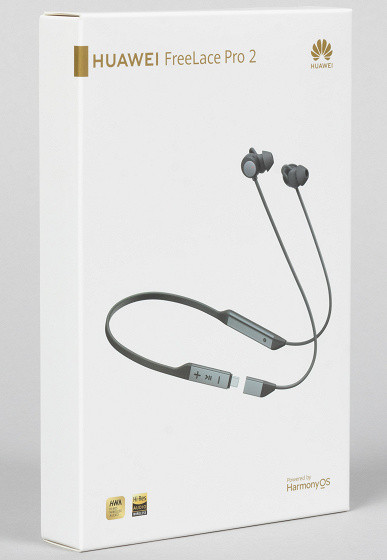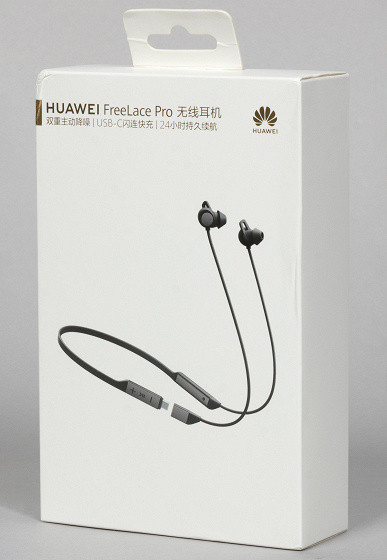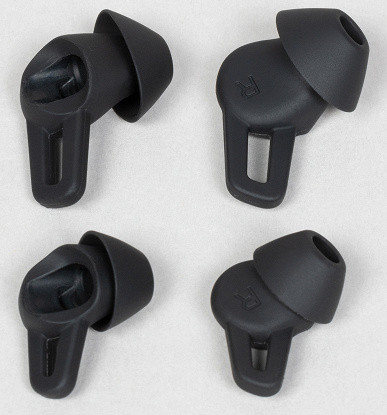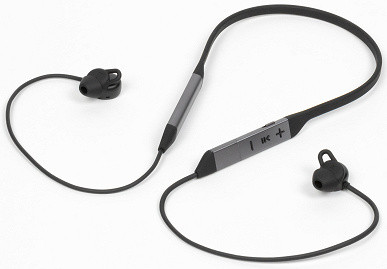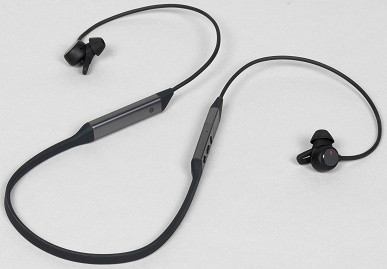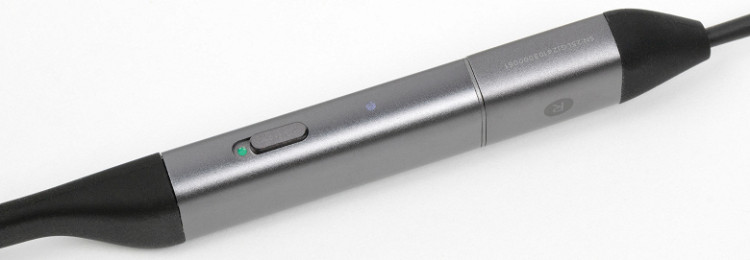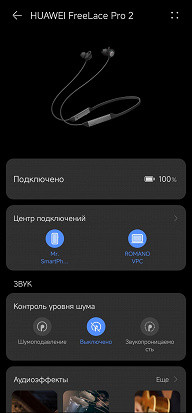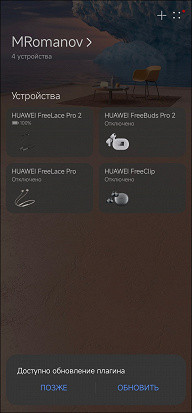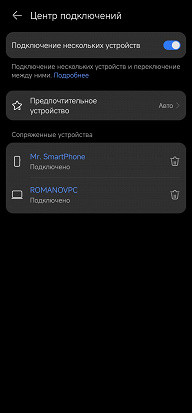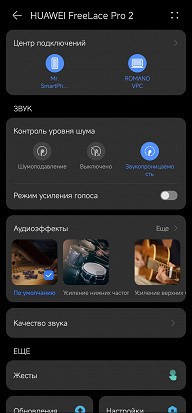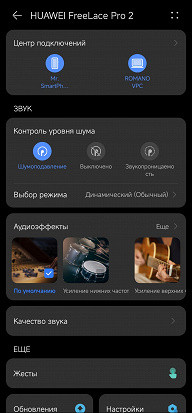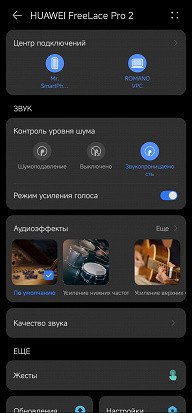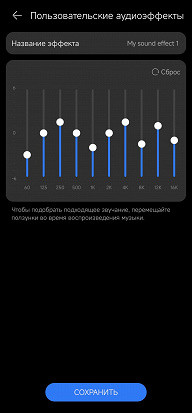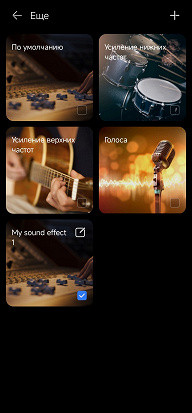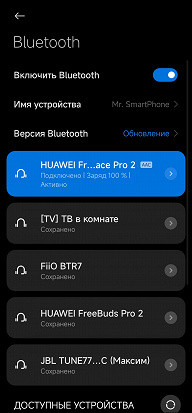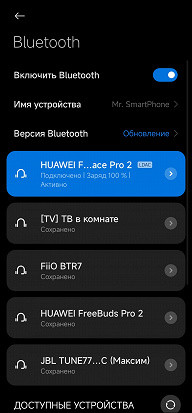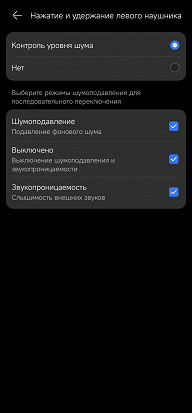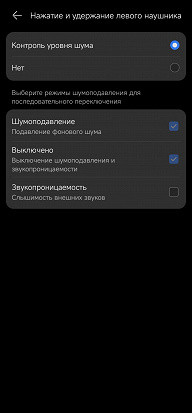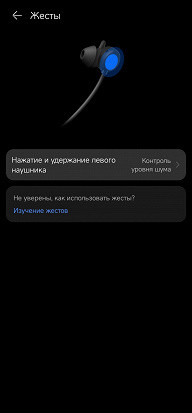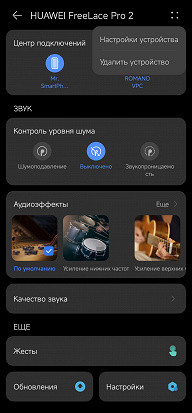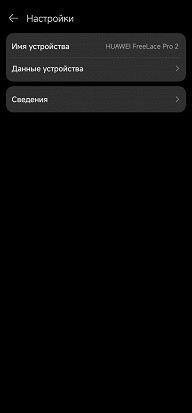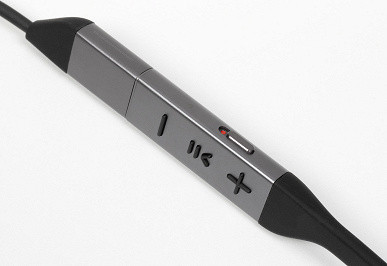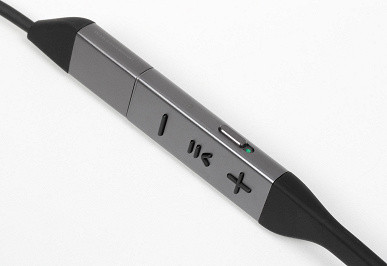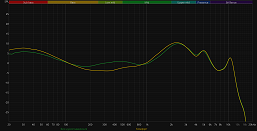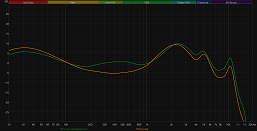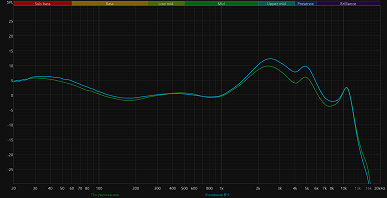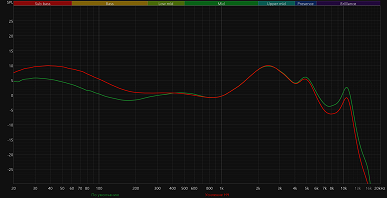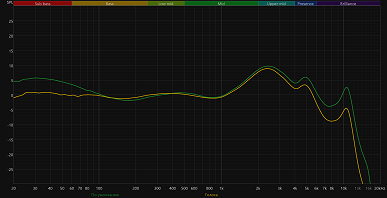We recently released a review of the Huawei FreeLace Pro wireless headset, which came to us thanks to one of our colleagues who prefers headphones with a neckband. This device format still has its audience, despite the popularity of TWS headsets. Readers reminded that the model is not new and our review is late, but we believe that an interesting and popular device always deserves attention. Therefore, today we will look at the second version of these headphones — Huawei FreeLace Pro 2.
This version is significantly different from the previous one: instead of large speakers with a diameter of 14 mm, there are more advanced speakers with a diameter of 10.8 mm. Thanks to this, the headset received Hi-Res certification, and the upper limit of the frequency range now reaches 40 kHz. The shape of the silicone tips has also been changed, a full-fledged multipoint and equalizer have been added, and the more advanced L2HC and LDAC have joined the traditional SBC and AAC codecs. So there really is something to discuss.
Specifications
| Model | Huawei FreeLace Pro | Huawei FreeLace Pro 2 |
|---|---|---|
| Speakers | ∅14 mm | ∅10.8 mm |
| Connection | Bluetooth 5.0 | Bluetooth 5.3 |
| Codec support | SBC, AAC | SBC, AAC, L2HC and LDAC |
| Multipoint | manual switching | supported |
| Control | buttons on the remote control, sensor on the earphone, software | |
| Active Noise Cancellation | There is | |
| Battery capacity | 150 mAh | |
| Battery life | up to 24 hours | up to 25 hours |
| Charging connector | USB Type-C | |
| Charging time | 1 hour | |
| Fast charging | 5 minutes for 5 hours of work | |
| Water protection | IP55 | |
| total length | 862 mm | 875 mm |
| Weight | 34 g |
Packaging and equipment
The packaging of Huawei products retains its recognition for many years — a white box with golden inscriptions, images of the device and brief characteristics. The differences in the design between versions are minimal: the second version added Hi-Res certification logos and the mention of Harmony OS.
Inside, the headset is neatly put into a cardboard lodge, its preservation during transportation does not certainly threaten anything.
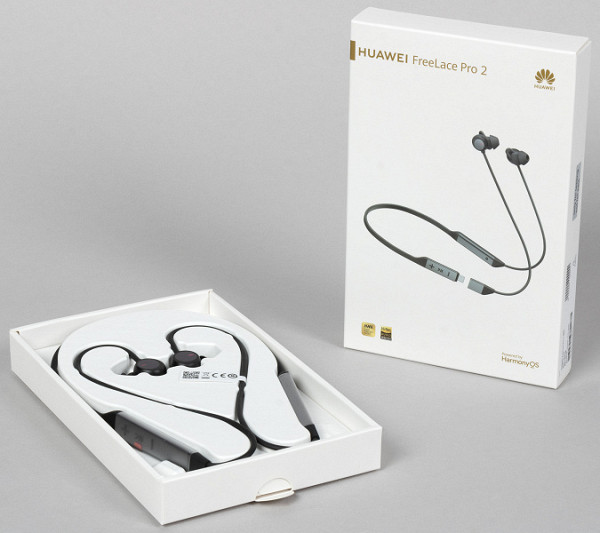
The Huawei FreeLace Pro 2 set includes the headphones themselves, replaceable silicone nozzles and instructions. Previously, the manufacturer also included the USB-A adapter (dad)-USB-C (mom), which allows you to charge headphones from more common USB-A ports. This time it is not included. However, fortunately, there are other methods of charging the device, which we will talk about later.
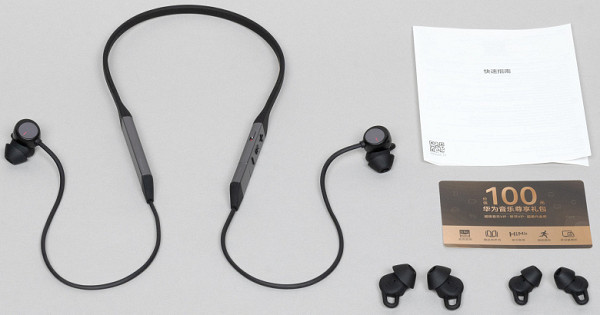
Silicone nozzles and additional stops for the auricle are again made in the form of a single part. However, the form of the stops themselves changed, they became more rounded.
Design and design
This time, the headset is produced in three colors: black, green and blue. For testing, we again got a classic black version. The cervical rim, as before, is flexible, with Soft-Touch coating, pleasant to the touch-in this regard, fortunately, nothing has changed.
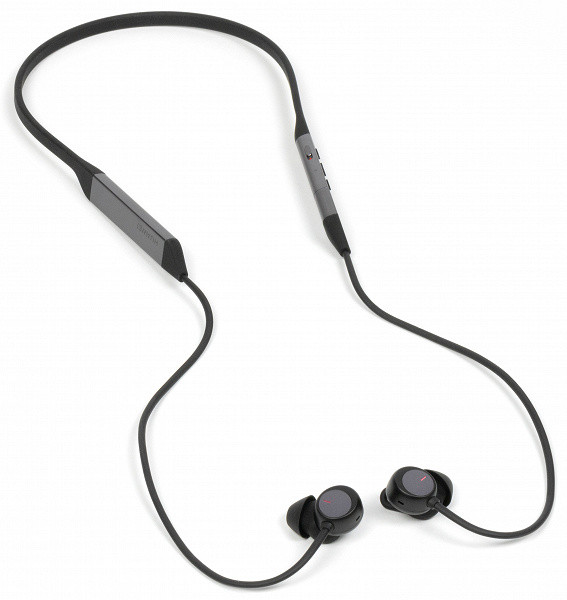
In general, both versions of Huawei FreeLace Pro look almost the same — at first sight it is difficult to distinguish them from each other. At the ends of the rim there are two metal elements: the battery is probably in the left, and the right is all electronics and control panel. The main differences relate to the internal device, but there are several noticeable external changes.
We have already mentioned a new form of silicone nozzles, but the second important innovation is a power switch. Instead of the button, a two -position switch with red and green dots on the inside, indicating the condition of the device, is now used. The small LED indicator remained in its former place.
The panel is located on the right on the cervical rim. One of the main “chips” of the device remained in its place: the right headphone turns off, freeing the USB Type-C plug, which serves for charging.
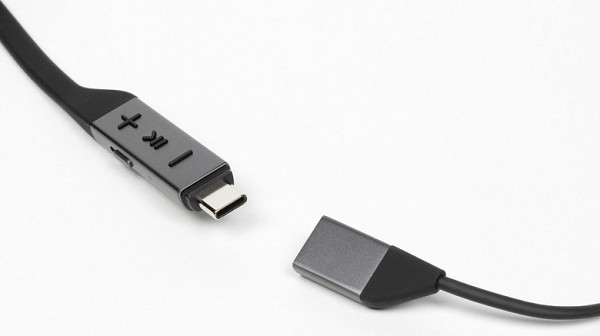
On the outer panel of the left metal part of the rim, the name of the manufacturer is applied — one of the few decorative elements of Huawei Freelace Pro 2.
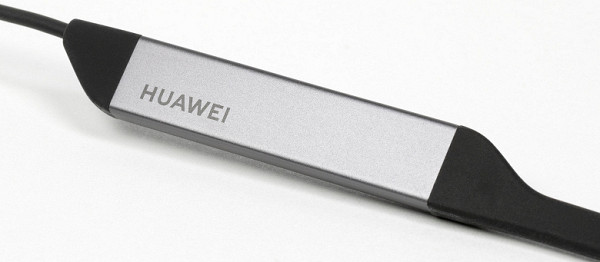
The shape of the headphones has not changed. They remain quite large — the distance from the rear of the case to the end of the silicone nozzle is about 26 mm. On the outer panel there are two slit -high elements that can be mistaken for LED indicators, but these are just small shiny overlays. The outer panels are equipped with a magnetic mount that allows the headphones of the headphones to gather with each other. This makes the wearing more convenient and allows you to quickly turn off and turn on the device.
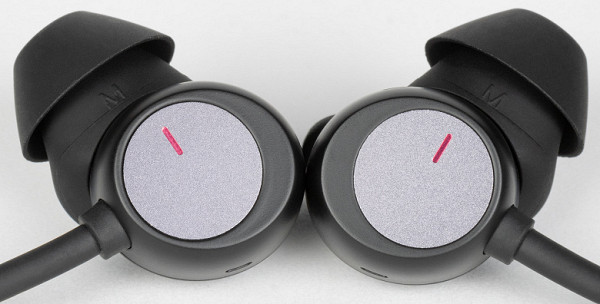
The length of the medium size of the silicone nozzles placed in the auricle is about 8 mm, in small ones it is a little smaller, in large ones it is slightly larger. In the previous version of the headphones, the nozzles were larger and had a different shape. Therefore, it can be expected that new nozzles will provide a more comfortable landing.
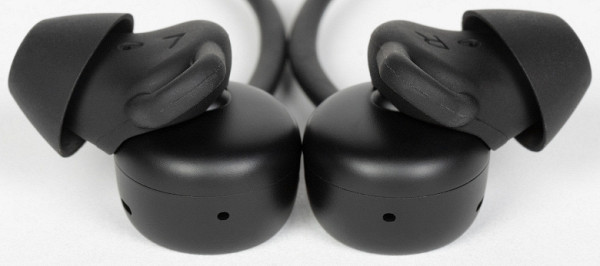
On the lateral part of the case there are two holes, behind which are hidden microphones responsible for the operation of the active noise reduction system.
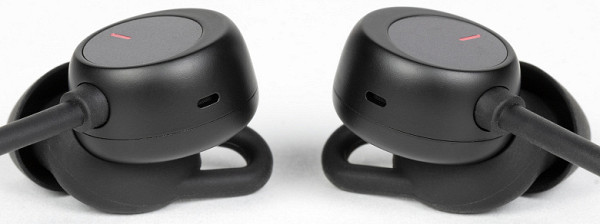
On the inside of silicone nozzles, the designations of the right and left headphones are applied. Next to them, you can notice compensation holes that serve to reset excess pressure during the operation of a dynamic driver.
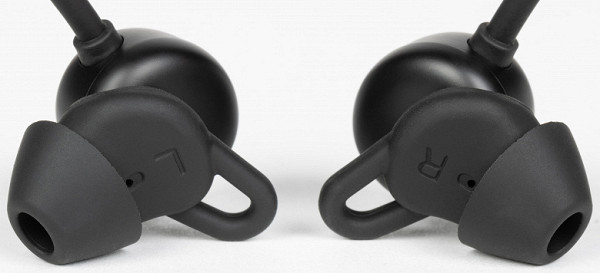
The nozzles are held in place with the help of a large ledge at the base of the sound engineer, and they are easy to remove and put them back. The soundspin itself became shorter, and an additional hole appeared on the side surface. This is probably part of the “design with four sound -conductive tubes”, which is declared by the manufacturer, designed to improve the sound quality of the headset.

The outer hole of the sound engineer is covered with a metal mesh, relatively deeply drowned inward — it will be difficult to clean it if necessary.
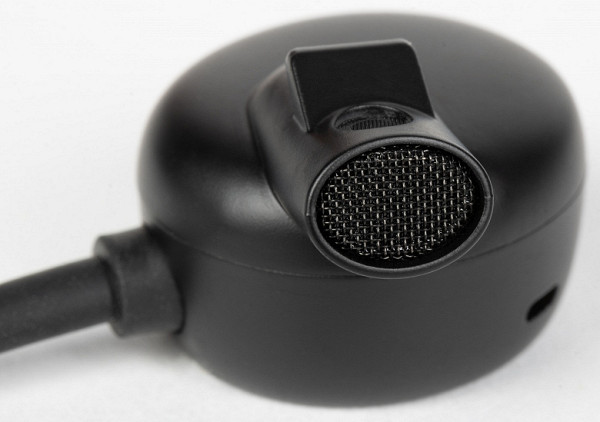
As already mentioned, the diameter of the driver decreased from 14 mm to 10.8 mm. However, this decrease in size is compensated by a more advanced design. The manufacturer calls this speaker “Ultra Magnetic Driver” and claims that it is 50% more powerful, and also provides pronounced bass starting with 15 Hz.
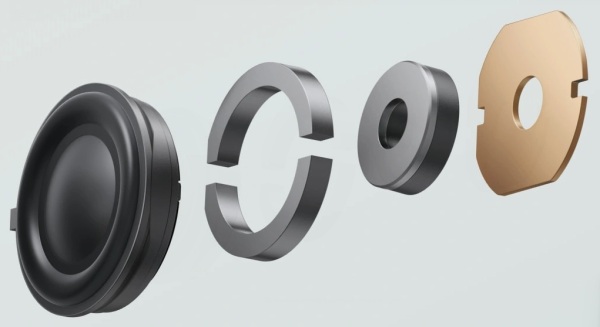
Connection
To connect the headset to the sound source, a classic method is used. Press and hold the central button for a few seconds to activate the interfacing mode. Then find the Huawei FreeLace Pro 2 in the Bluetooth menu for your smartphone and click on it — ready. Owners of Huawei and Honor smartphones can use the “express version” of connection, known as Huawei Hipair: just insert the plug into the Type-C connector, and a request for conjugation will appear on the screen. Although at present functions such as Google Fast Pair are no longer something new, the standard connection takes only a few minutes. However, this option can be convenient for some users.
The previous version of the device did not support a full multiplayer — between the sound sources, you could switch by double pressing the power button. In the second version, the multipunte has become available and works completely correctly: the switching between the two connected devices occurs automatically and quickly. During the testing, we easily connected Huawei FreeLace Pro 2 to the smartphone on Android and PC with Windows 11. Using the Bluetooth Tweaker utility, a complete list of supported codecs and their modes was received.

The utility showed that three codecs are supported — SBC, AAC and LDAC. The BitPool parameter for SBC is set at 53, which is slightly higher than the recommended value in the High Quality profile, which allows the codec to work at maximum performance. At the same time, the upper threshold of the bitrate of the AAC is set at 192 kbps level — noticeably lower than the maximum value. Presumably, the manufacturer reduced this parameter to ensure a more stable connection between headphones and a sound source.
It is also worth noting that the LDAC codec by default is disabled and it must be turned on through the AI Life application or the smartphone menu. In addition, there is support for the L2HC codec, but it can be inaccessible in the utility used for testing. To use this codec, a Huawei smartphone with Emui 13.0 or new is required. Huawei smartphones can also use the Share Audio function that allows you to connect two pairs of headphones to the same device.
When using the regime of priority of the quality of communication, there are no problems with the stability of the connection, but when activating LDAC, problems with “stuttering” of sound can occur, even if the smartphone is in the pocket. Sound and images can also occur when watching videos or games, but this happens only in quality priority mode. If problems arise, you can enable the «delay reduction» through the application.
Management and software
To configure Huawei Freelace Pro 2, the Huawei Ai Life application is used. After connecting the headset, she immediately appears on the selection screen, and you need to go to the control page. You may need to update the appropriate plugin. On the main screen, the charge level is displayed, and below is the connection control module to the sound sources. You can choose the preferred device, although in automatic mode everything works without problems.
Below is the control system of active noise reduction. Three operating modes are available in the application that can be selected, or switched by touching the touch external panel of the left headphone. The “sound transparency” mode is also provided, with the activation of which the microphones of the headset transmit external sounds to the headphones, which helps to hear ads in transport or answer the question of a passerby. Separately, you can enable the «Voice Acards», which forced the average frequencies and helps to better distinguish between the interlocutors.
Appeared in the second version and a full-fledged 10-band equalizer, the presence of which we are especially happy. There are only four presents, but you can additionally add your own.
As mentioned earlier, “advanced” codecs must be activated separately. By default, the priority mode of the quality of the connection with the AAC codec is used. If you enable the “sound quality priority”, then it will automatically switch to LDAC (or L2HC for Huawei smartphones).
Noise reduction modes can be switched by touching the sensory zone on the left headphone. You can configure what modes will be activated in the Huawei Ai Life application, and also turn off this option completely. If necessary, you can take a short training course that will help you familiarize yourself with all the settings of the set of set.
In the settings section there is an inclusion of a decrease in sound delay, you can also see the current version of the firmware, change the name of the device or remove it from the application.
The control panel is located on the right end of the cervical rim. The buttons are convex and have a different shape, which makes it easy to distinguish them by touch even after prolonged use. Pressing the buttons is a little heavy, especially the volume reduction buttons due to their small size, but this does not cause serious inconvenience. Click is distinct, which provides confidence in the buttons.

Volume buttons are designed only to adjust the volume level. The central key is multifunctional: short pressing controls reproduction and calls, double pressing the track forward, and triple back. Although it would be more convenient if these functions were assigned to double or long -term presses of volume buttons, but this is not. Pressing on the central button for two seconds launches the Bluetooth tightening process, and for 10 seconds resets the settings to the factory.
Turning on and off is carried out by a two -position switch with red and green points on the inside, which serve as indicators of the condition. The headset also automatically turns off when the magnetic external headphone panels «stick together» while wearing on the neck.
After prolonged downtime, the headset may disconnect, even if the switch is in the “inclusive” position in order to save charge. For repeated activation, you just need to click the switch back and forth.
Exploitation
Headphones with a cervical rim like Huawei FreeLace Pro 2 have a number of features that affect the comfort of their use. You should start with the distribution of weight on the neck and material from which the rim is made. In this model, everything is at a high level, like the previous version: the headset does not shift during movements, and the soft coating provides reliable fit to the neck. The rim is durable and flexible, it is easy to bend and store without worrying about damage.
Fixation in the ears is also reliable: conical silicone nozzles are well recorded in the auricle, and special arcs provide additional support. Unlike the previous model, the angular arcs are now rounded, which makes the wearing more comfortable. However, the use of various elements to enhance fixation, depending on the size of the user’s ears, could make this design even more convenient.
By the aggregate of these factors, Huawei FreeLace Pro 2 is ideal for sports, which is important, given that such headphones are often used in active conditions.
The manufacturer announces an improved Intelligent ANC 2.0 noise supply system, which uses two digital microphones in both headphones and one MMMS microphone. Three operating modes are provided: “ultra” for strong noise, “ordinary” for everyday situations and “comfortable” for quiet places. Additionally, there is a dynamic mode, switching between the main modes depending on the surrounding noise. Noise reduction works effectively, especially at low frequencies, but for high noise a more powerful system may be required.
Voice Microphones
This time, the manufacturer announced the presence of 4 digital microphones (2 in each headphone), which are used for the operation of the active noise reduction system. However, we are currently interested in the only MEMS microphone placed in the right thickening on a rim and intended for voice communications.
To measure the frequency-amplitude characteristic (frequencies) of microphones, we use a specially prepared room and a monitor acoustic system to play the tops. Since the frequency response of the columns is heterogeneous, we first get a graph using a calibrated measuring microphone. Then these data are used to create a corrective profile, which compensates for acoustics. The recorded signal using the hero of testing, which occupies the same position as the measuring microphone, is adjusted using the created profile, which allows you to obtain the frequency response of the tested microphone.
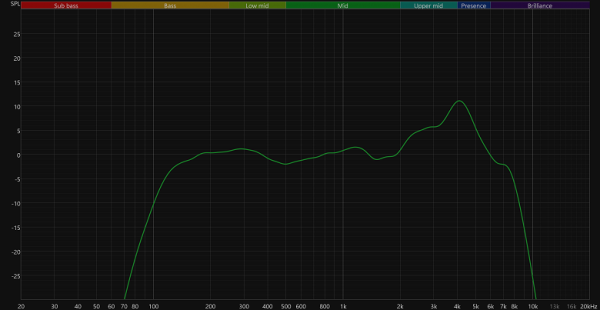
The voice of an adult man usually has the main frequency of 85 to 155 Hz, while in women this range is from 165 to 255 Hz. However, frequencies from 300 to 3400 Hz are most often used to transfer voice, known as «voice». This range contains formant, which are responsible for the intelligibility of speech. The frequencies below this range are usually cut off due to the presence of undesirable sounds, such as the hum of motors or the low-frequency noise of the crowd.
The tuning of the microphone is extremely logical: the edges of the range are usually cut, and in its remaining part we see only one pronounced peak in the area of 4 kHz, which plays an important role in the intelligibility of speech. It is expected that the Huawei FreeLace Pro 2 microphone will cope with this task — let's see if our expectations will be justified.
The voice sounds quite vividly and legitimate thanks to the microphone settings. With Huawei FreeLace Pro 2, you can confidently participate in online conferences or answer calls. The headset is also equipped with an advanced noise reduction system for calls, which we will also check. To do this, we will add a background noise to the recorded tracks, turning on the sounds of a lively street next to the recording site.
External noises are practically not heard thanks to the effective work of noise reduction. The noises of cars and other sounds do not penetrate through this remedy. Although the voice may sound a little less natural due to noise reduction, its intelligibility remains at a high level. This test confirms that a high -quality voice signal is well perceived even in the conditions of background noise.
Work and charging time
Autonomous work time is slightly higher than that of the first, reaching up to 25 hours without the use of noise reduction. The battery capacity remained the same — 150 mAh. This can be due to the more energy -efficient work of Bluetooth 5.3. Huawei provides testing data, clarifying the conditions for obtaining results. Audio was used in AAC format, the volume level was 50%, and active noise reduction was turned off.
We conduct our autonomy tests differently, focusing on the real volume instead of the position of the regulator. The safe level of sound pressure when listening to music is 75 dB, but most prefers the level of 90-100 dB. We convey to the headphones the white noise with a sound level of about 95 dB and write down the duration of each headphone to evaluate the real time of autonomous work.
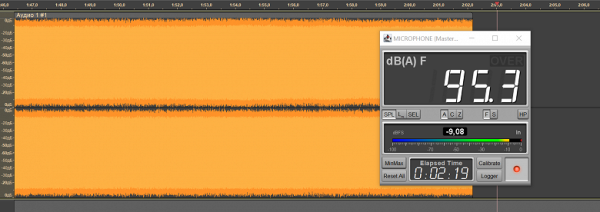
Traditionally, we will try to discharge the headset with the noise reduction turned on and off; we will test the latter in maximum efficiency mode. We will summarize all the data obtained in a table.
| Noise canceling is off | Test 1 | 22 hours 20 minutes |
|---|---|---|
| Test 2 | 22 hours 14 minutes | |
| Total | 22 hours 17 minutes | |
| Noise cancellation enabled | Test 1 | 15 hours 43 minutes |
| Test 2 | 15 hours 34 minutes | |
| Total | 15 hours 38 minutes |
The autonomy results are slightly lower than the declared, but are still sufficient for the comfortable use of the headset. With periodic use for office trips, walks and training, charge will be enough for a week. However, it should be borne in mind that testing was carried out using the AAC codec, which is usually sufficient for everyday situations. When using more resource -intensive codecs LDAC or L2HC, autonomy is reduced. For example, with LDAC, the headset worked for about 17 hours.
In addition, fast charging is supported: in 5 minutes, the headset can receive a sufficient charge for 5 hours of work. In practice, the charging time turned out to be a little more — about 5 hours 20 minutes when using the AAC codec and the noise reduction. You can charge the headset from a device with a USB Type-C connector that supports USB OTG. This is convenient and practical, especially given the prevalence of the USB Type-C port on modern devices.
Sound
As mentioned earlier, Huawei FreeLace Pro 2 has new speakers that promise increased sound quality with smaller sizes. We will now check this promise. Also in the headset, an algorithm for adapting the volume level, providing stable sounding, is implemented. Although it is impossible to turn off this function, we can share our subjective impressions: the system affects the sound very delicately, so a huge “wow effect” should not be expected. But in general, the sound of the headset is very worthy for its price and design.
The low frequencies are slightly reinforced, but it depends on how tightly the nozzles sit in the ear passage. The average frequencies are clear and detailed, and high frequencies are slightly emphasized to improve the perception of sound quality. In general, a high -level frequency balance. Although these are not audiophile headphones, they offer excellent sound quality in their price and functional range.
We note that the frequency response graphs are used exclusively to illustrate the features of sound. The real sound depends on many factors, ranging from the anatomy of the ear to the type of nozzle used.
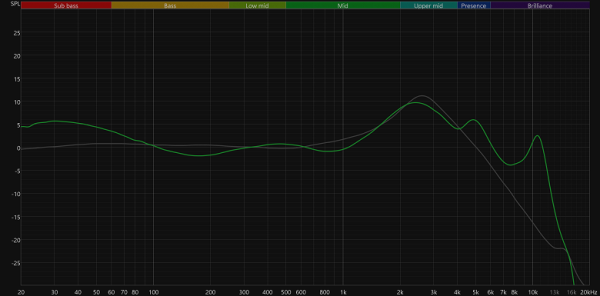
The graph above shows the IDF curve (IEM Diffuse Field Compensation), provided by the manufacturer of the stand that we used. This curve serves to compensate for resonant effects in the simulation of the auditory channel and the characteristics of the equipment, creating a «sound profile», which most accurately reflects the perception of the sound with the listener. In fact, this is an adapted version of the so -called “Krivoy Harman”, developed by the Harman International team under the leadership of Dr. Sean Oliv. We adjust the received frequency response in accordance with the IDF curve.
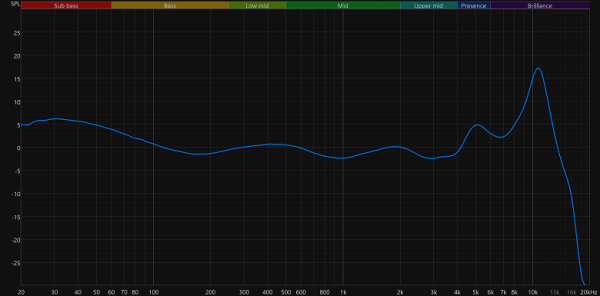
In this form, the schedule clearly illustrates the subjective impressions of listening — except that the peak on the RF in reality is not perceived as acutely as it looks in the picture. Almost any more or less decent working system of active noise reduction traditionally affects the sound, especially in that part of the range where it is most effective, that is, in the area of the LF registry and the lower middle. Let's see how the frequency response changes when activating various modes of “Summier”.
The Comfort mode slightly eliminates the evenness and detail of the average frequencies, but this is not critical. In the «ordinary» mode, this feature is even more pronounced, and the «ultra» overloads the sound, which is suitable only for the noisy media. Each preset of the equalizer does what he promises. At the last illustration, we use the profile we created, raising the average frequencies and lowering the rest. The equalizer is effective in the middle of the range, although the edges remain insufficiently configured. However, this is a significant improvement, and its presence is another advantage of the headset.
When comparing the sound of two versions of the headset, it is clear that they are related, but the new version is a significant movement forward: the middle sounds more evenly, the emphasis on its upper part has become more balanced. As before, the degree of severity of low frequencies depends on the position of the silicone nozzle in the auricle and its fit.
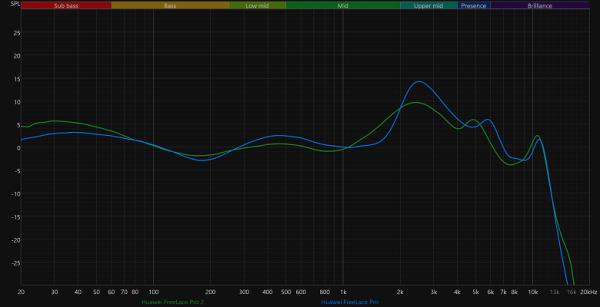
Results
The second version of the headset was an excellent choice for fans of «headphones with a rim.» If the past model was already good, then the new one brought significant improvements, correcting almost all the controversial moments and adding a number of necessary functions. Improvements begin with a more comfortable landing due to the modified form of ear stops and end in adding a full multipond and equalizer. Despite some minor flaws, such as the lack of cable for charging in the kit, and somewhat uncomfortable management, the overall result can only be praised. The sound of headphones has improved significantly compared to the previous version, noise reduction works effectively, the voice microphone copes with its task, and autonomy and fast exercise add convenience in use.

